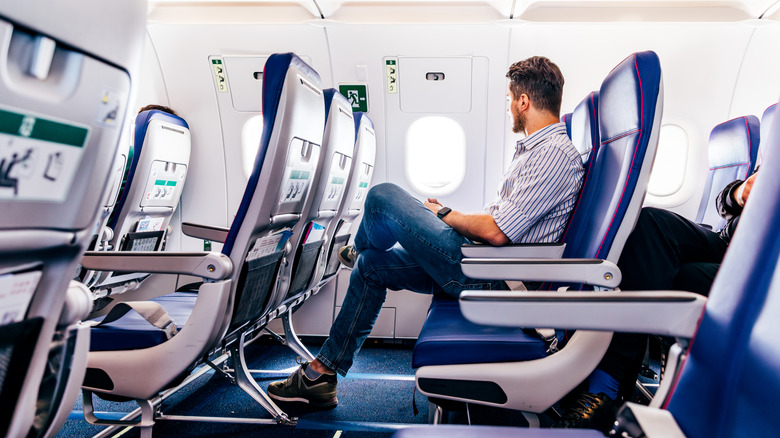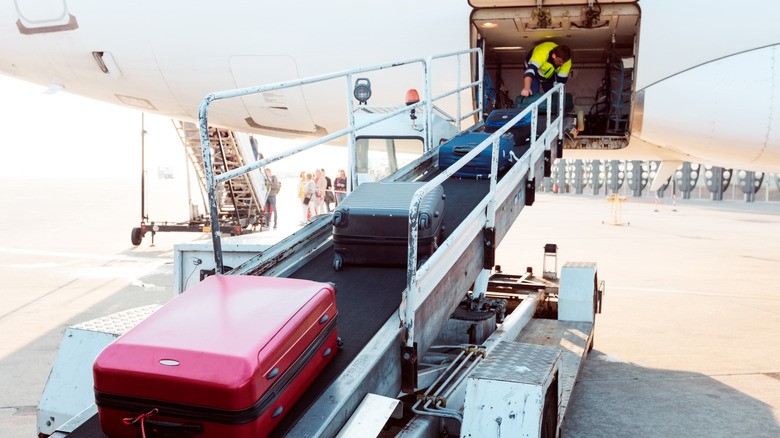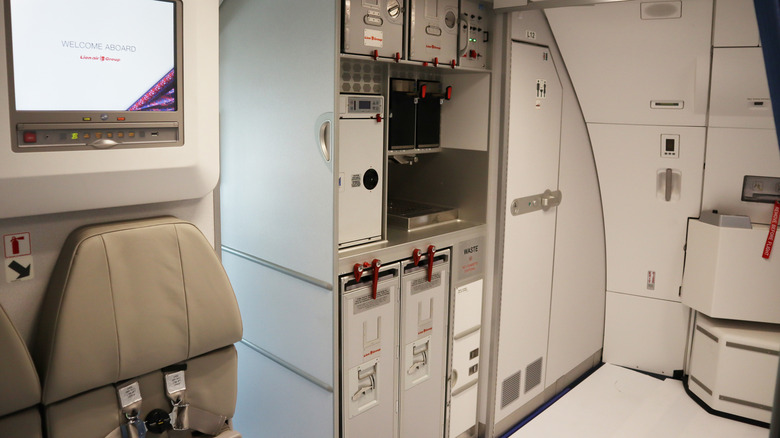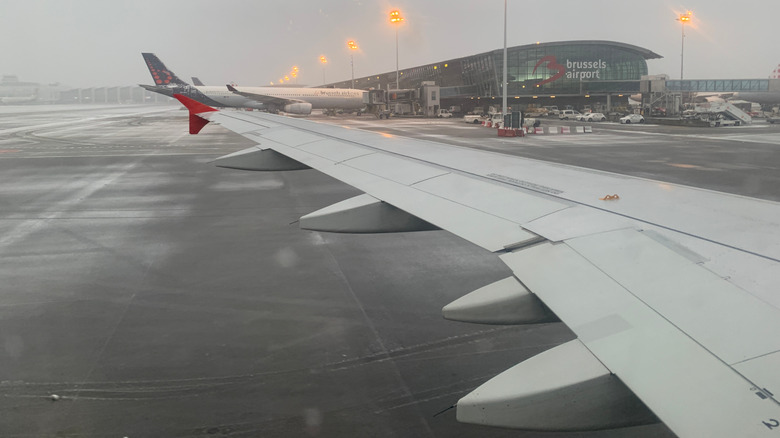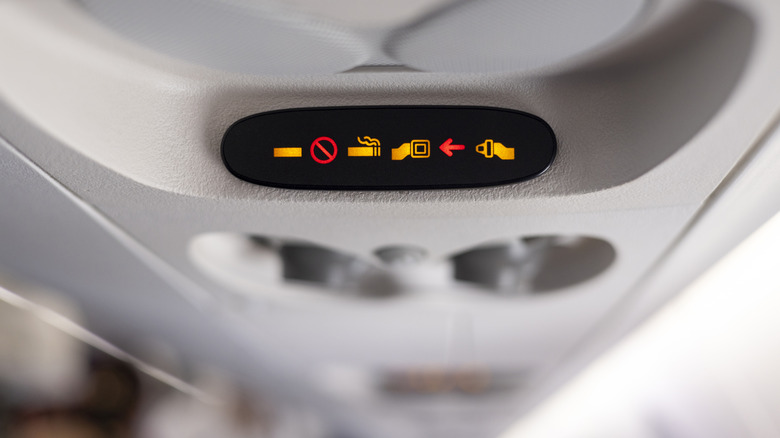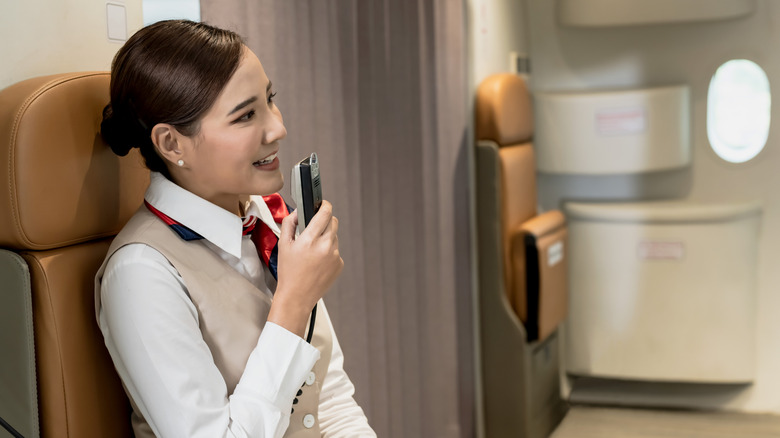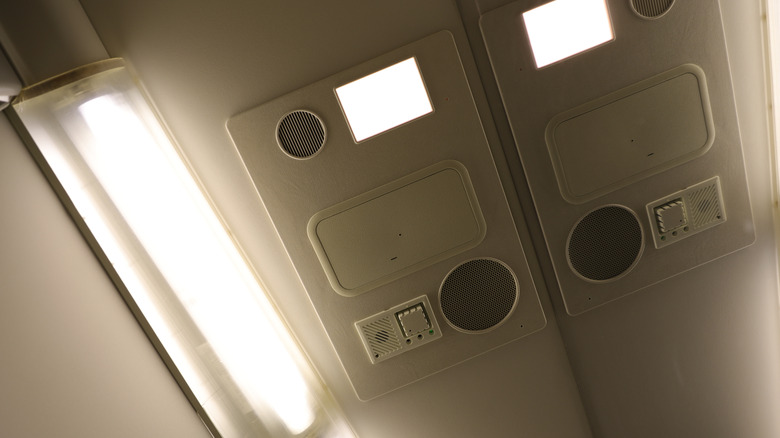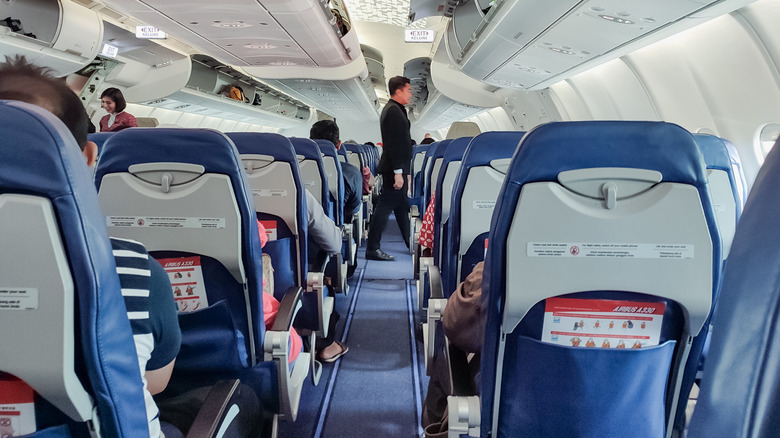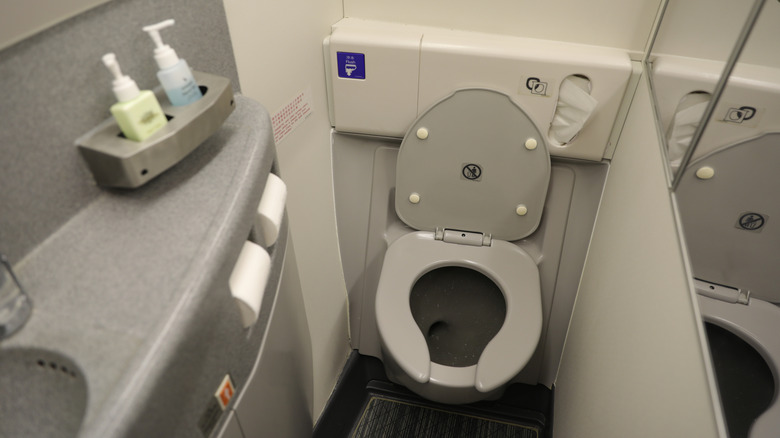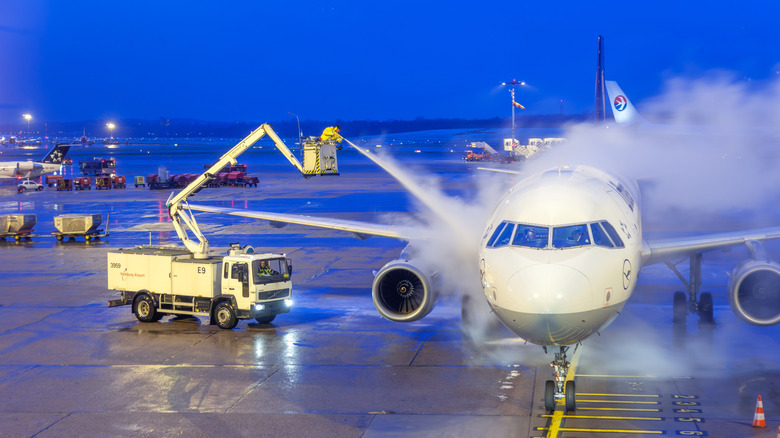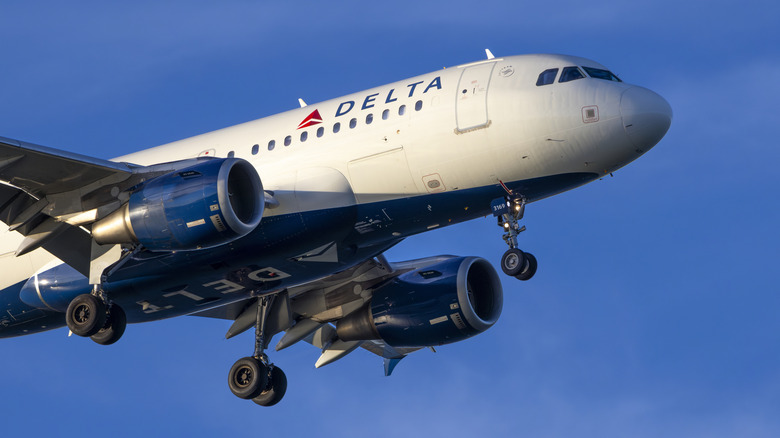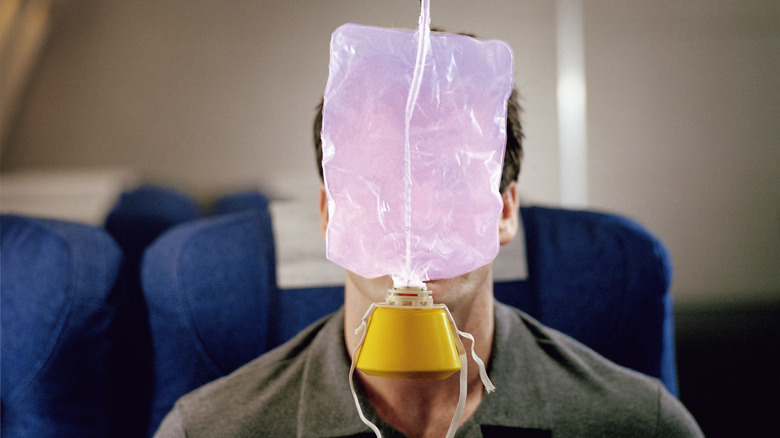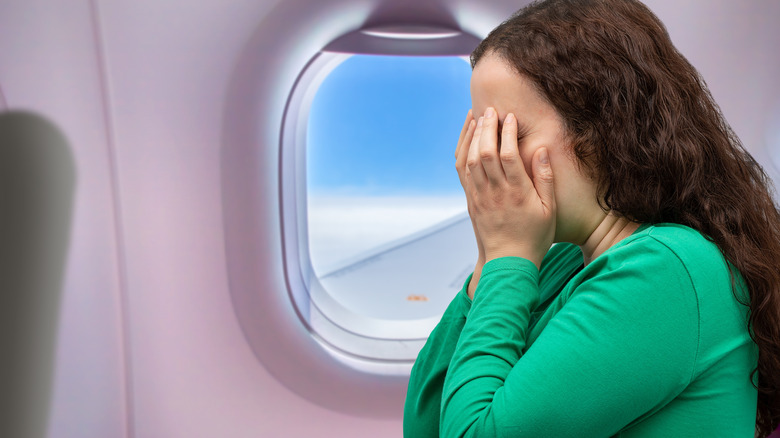The Ultimate Guide To Understanding What All Those Weird Plane Noises Really Mean
For many, boarding a plane is entering the realm of the unknown. It's a time when we, as passengers, have absolutely no control over our fate. We place our trust in a select few individuals placed far away, unless you sit in one of the premium classes (though there are reasons to avoid first-class seats), hoping that they can close out another successful flight and transport us all from A to B. Many travelers might want to ignore these details, but the reality is that flying requires sitting in a metal tube, hurtling thousands of feet above the sea at speeds that are hard to fathom. These are difficult concepts to grasp, and the whole experience is unlike anything we encounter in most of our daily lives.
As such, we might not understand some of the strange sounds that are part of the flying experience. Hearing those unfamiliar sounds, especially when the plane is airborne, can send us spiraling into a state of dread and panic, especially if you're stuck on some of the longest flights in the world, where landing in the middle of an ocean is not an option. A strange thunk or thud might be an omen for a crash, a squeak might suggest a bad window seal, and perhaps you'll get sucked out of the plane like a vacuum cleaner yanking up a piece of fluff. Luckily, most of the sounds you hear on a flight are harmless, routine noises that signify nothing more than the normal operation of a normal flight. Islands spoke exclusively to two experienced flight attendants — Janna Barrett and Johanna — to find out what all those noises are and why they aren't a cause for concern.
Bumps under your feet
Congratulations! You have managed to make it through security screening and the seemingly endless wait at the gate to finally board the flight. As you find your seat, stow your carry-on bag, and settle in, you detect some strange bumping noises beneath you. They sound like somebody is rearranging furniture, or maybe somebody is trying to sabotage the plane by tampering with something in the fuselage? Janna Barrett, an attendant with a major airline and a writer at Medium, explains what you are hearing. "The bumps below are the baggage handlers loading the suitcases and any other cargo." Barrett notes that commercial airlines also offer cargo shipping services, so it's not just the suitcases that are in the plane's hold.
Bags are loaded into the aircraft in one of two ways. They might be placed in special containers, which are then transferred directly onto the plane in their entirety. Or they may be individually loaded using a conveyor belt to unload them from a baggage pallet and whisk them into the storage area at the bottom of the plane. In the latter case, someone from the ground crew will be physically inside the cargo hold, placing the bags in the compact space, and this is how the bumping sounds occur. The most resounding bump or thud below will be when the loading is finished and the ground staff shut the cargo door.
Banging on the plane
A flight is never a silent experience. You are surrounded by hundreds of other passengers, and humans tend to make some noise. There are compartments to be opened and closed, toilets to be used, and culinary delights waiting to be devoured (especially on the airlines with the best in-flight dining). If you hear a lot of banging while onboard the plane, there's a good chance it is food-related, as Janna Barrett explains. "Banging in the galley happens when catering loads the carts and carriers with all the food and beverage items." Those carts are heavy and a little unwieldy, not the easiest accessories to maneuver.
When fully loaded with drinks and ice, the carts can weigh 250 pounds, so sliding them smoothly into place isn't always easy or quick. There are days when the work needs to be completed as the passengers stream in, as Barrett points out. "Sometimes this is done before passengers are onboard, but it does happen during boarding. The noises could also be the flight attendants making sure we received everything from catering, or reorganizing things for our needs."
Grinding by the wings
We will admit that this one might sound a little frightening. The wings are a key part of the plane, and without them, an aircraft would never be able to take off. The difference in air pressure above and below the wings is what creates lift, allowing the plane to rise and remain airborne. If a wing is compromised in any way, it can have a significant impact on the plane's ability to fly. Should you find yourself in a row near a wing — but only on a specific type of plane — and hear an unpleasant crunching, scraping sound, try to not be alarmed, as Janna Barrett explains.
"If you're on an Airbus and sitting near the wings, then during taxi, you will probably hear a repetitive grinding noise. That's the power systems gearing up for flight, and it's unique to the Airbus." She likens the sounds to that of a dog, stowed in the cargo hold under the passengers, barking with unbridled vigor. If you hear such a noise, accept that it doesn't signify mechanical parts of the plane malfunctioning but rather the normal ramping up of power that will send the aircraft up, up, and away.
A double ding near the beginning and end of flights
We all hear short-pitched sounds in our daily lives, from phone notifications to microwave timers and beyond. Those sounds are so ingrained in our days that we almost don't notice them. However, in a plane, which can feel like a theater with everyone sitting in rows and rapt with attention, certain sounds seem to amplify in their intensity. One of these is the double ding that reverberates at very specific points in the flight, as Janna Barrett conveys."A few minutes after takeoff, and about 15 to 20 minutes before landing, you'll hear the double ding. That's the sound of the seatbelt light turning on and off — but it doesn't mean you can unbuckle your seatbelts!"
While passengers might believe that they have been given the go-ahead to slide out of their safety belts and roam the cabin with abandon, the double ding serves an entirely different purpose. "During those stages of flight, that's used as a signal from the pilots to the flight attendants," continues Barrett. "Anytime we're below 10,000 feet, the pilots are managing critical phases of flight, which require extra focus. It's called 'sterile flight deck.'" During this phase of flight, attendants aren't allowed to communicate with the pilots unless it is for a genuine emergency or an issue of safety or security. Flight attendants don't have altimeters that allow them to gauge the plane's altitude (and their seats don't come with screens that display such information), so the double ding on ascent notifies them that the aircraft has passed 10,000 feet, and they safely can contact the pilots. On descent, the double ding serves as notice that the plane is below 10,000 feet, and the pilots are, again, off-limits.
Chimes galore
Another two-tone sound is the double chime that might be heard throughout the flight. This combines both a high and low tone, almost like that of a standard house doorbell. This sound, while audible to passengers, serves no demonstrative purpose for travelers, as Janna Barrett declares. "[It] is the sound our phone makes when we call each other." Attendants need to be in constant communication with each other during a flight, and they will often find themselves at opposite ends of the aircraft. The internal phones are the quickest and most convenient way for an attendant to contact their colleagues. But this is just one of the chimes that passengers might hear during a flight. "A high single chime happens anytime a passenger pushes their call button," reveals Barrett.
This is the button usually located directly above a passenger's seat and is used when the flier has a question or wants something to eat or drink. It is also used when a passenger is in distress and needs help. "That's our cue to go check on the people at that seat and see how we can help them. It could be anything from bringing some earbuds to responding to a medical emergency," discloses Barrett. Finally, there is the low single chime that accompanies the seatbelt sign being turned on or off. "This is your best indicator about the safety conditions," says Barrett. "If it's illuminated, that's for a reason — even if it seems safe to you. Stay seated and buckled up anytime the seatbelt sign is on."
A constant beeping
While the chimes discussed so far come in short, staccato combinations, there is another kind of piercing sound that just goes on and on. According to Johanna, who will celebrate 10 years as a flight attendant in November 2025, this sound is associated with a warning of sorts. "When the smoke alarm is activated in the lavatory [restroom], it's likely that there will be an insistent beeping, chirping, or a high/low chime, all of which will sound more insistent than the regular chimes you hear from announcements or use of the inter-phone."
If this sound occurs, Johanna notes, the crew will make a beeline for the lavatory and try to open it. "This is not an immediate cause for concern, as the crew is fully trained to handle the situation," Johanna continues. "It is rare that this alarm has detected a real fire — there is typically a less dangerous cause, like a passenger smoking or vaping." Such smoke detectors are required for planes that carry 20 passengers or more and are typically mounted in the ceiling or ducts of the toilet in a location where they will capture the wisps of smoke that waft up. They feature a dedicated chamber that detects the smoke and connects to warning lights and sounds when triggered. The noise will continue until the smoke clears. In case you are wondering, vaping can also set off these alarms.
Creaking sounds
Anyone who has a home with old wooden floorboards will be used to the sound of creaking. It is a noise that is almost comforting, one filled with nostalgia, history, and character. The sound of creaking on a plane, however, isn't quite so laden with romance and charm. It suggests that something isn't quite as tight or secure as it should be. In certain sections of Airbus planes, remarks Janna Barrett, creaking will be evident, but it is not a cause for panic.
"The galley areas in the Airbuses can also make creaking sounds during takeoff and landing. From what I understand, that's the plastic housing for a lot of the components. It doesn't sound pretty, but it's completely normal, and it's nothing to be worried about." She adds that these only generally occur early on in the flight and again when the plane is preparing to land. At these times, the seatbelt sign will be illuminated, and passengers should be in their seats. As a result, it will mostly be the cabin crew who will hear this sound.
A whooshing sound
Airplane toilets aren't the most commodious of places on a plane. They aren't meant to be. They are designed for maximum efficiency, small slivers of space that passengers will only visit fleetingly when nature calls. Passengers seated near them might not need to use the restrooms during the journey, but they will likely hear the distinct noises coming from the mechanisms within, Janna Barrett explains. "Near the bathrooms, you'll hear what sounds like a loud motor or whooshing. That's the vacuum system for the plumbing, and it happens anytime the toilet is flushed."
Barrett admits that the sound is very loud, and there is a reason for this. In standard household toilets, water and gravity help with the flushing of any deposits within the bowl. Carrying water on a flight is impractical (think of all the added weight), so plane toilets flush by using differences in pressure. There is lower pressure in the void below the toilet, so when the flush button is pressed, the low pressure literally sucks the air and the contents of the toilet into it. With that in mind, be sure to close the toilet lid before flushing.
A hard, crackling sound
This noise, which is only likely to be heard during the colder months, comes from the exterior of the aircraft but can also be heard inside the body of the plane. "During the winter when there is inclement weather such as freezing rain or snow it is necessary for the outside of the plane to be treated with de-icing fluid," explains Johanna. Mobile de-icers will position themselves alongside the aircraft, "and strong sprays of liquid will hit the sides of the plane, including the windows, a bit like the high-powered jets at a car wash."
The sound can be very loud and quite uncomfortable to listen to. It can sound like thunder or hail pattering on the side of the plane or even like someone scraping ice off a car windshield in the winter. The vibrations accompanying this can be disconcerting to passengers who are already nervous about being on a plane, but they should try to stay calm.
Grinding or whining below before landing
Wheels are a vital component of a plane, but they are only visible on large commercial aircraft for short periods of the flight. They help the plane roll forward at high speeds during take-off, and then, for most of the flight, they retract into the fuselage, staying out of the way. Shortly before landing, their services are once again called into action, as Janna Barrett mentions, and that is when the noise kicks in. "During final descent [only a few thousand feet from the ground], you'll hear a grinding noise and might feel some vibration at your feet. That's the landing gear [wheels] being put into place, or what we call, 'being dropped.'"
What actually happens is that hydraulic mechanisms are engaged, opening the doors to the landing gear and lowering the wheels down. That is what causes the sounds when the aircraft approaches its final destination (be sure to get a window seat if you're visiting one of the world's most breathtaking airports). The wheels not only allow the plane to touch down on firm land and bouncily taxi to the gate, but they also help absorb the impact of the landing.
A loud pop
The sounds we've covered so far have been innocuous bumps, bangs, and pings that are nothing to worry about. However, this one is a little different, as Janna Barrett discloses; "If you hear a loud pop, that would likely signal an issue with the air pressure in the cabin. In that case, the pilots are alerted immediately and will respond accordingly." Should this happen, in addition to the distinctive sound, the oxygen masks will automatically drop. Before you start to panic and fear that this might happen on your next flight, note that this is a very rare occurrence. "This situation is extremely unlikely," continues Barrett. "I've never seen it happen."
Johanna adds that the pop sound "would be indicative of a rapid decompression, where air pressure is lost immediately." Another related issue is much less obvious but also signifies changes in air pressure. "There can also be something called an insidious decompression, or the slower loss of air pressure," Johanna explains. "This can go unnoticed for a long time, but one of the biggest signs of an insidious decompression would be a noticeable hissing sound that could come from anywhere in the cabin." She is quick to stress that passengers that hear a clear hissing sound, especially if it is coming from near the emergency exit, or a window, should tell someone in the crew immediately.
Tips for nervous fliers
Flying can be a stressful experience. You might lose your sanity if you fly on one of the worst days of the year, or you might be taking your first flight and find yourself wracked with fear (you can ease your mind by avoiding these first-time flyer mistakes). You are entering into a realm of the unknown where you no longer are in charge of your own destiny. It is little surprise that many fliers are nervous, but our experts have some strategies to help. Johanna suggests telling the crew that you are anxious at the time of boarding. "They'll let you know what to expect, and inform you of any anticipated turbulence." They can also check in on that passenger during the journey. Johanna also believes that staying busy helps the time go quicker — so reading a book or listening to an audiobook, downloading a movie to a personal device, and talking to neighbors all make the journey skip by more painlessly.
"Many people dislike flying because of the perceived lack of control, so it's helpful to bring things that will give you your own choices to make." Fliers who encounter strange sounds that send them into a psychic tailspin should immediately contact the crew. "We have more knowledge about what's happening at any given moment, and we are trained for every scenario," explains Janna Barrett. While some fliers take a sedative to relax, Barrett warns against using alcohol as a way to cope. "That can alter your emotional state, and therefore might only make you more nervous. [We also have to make sure all passengers can respond to an emergency situation at any time, so that's why we monitor alcohol consumption onboard.]"
